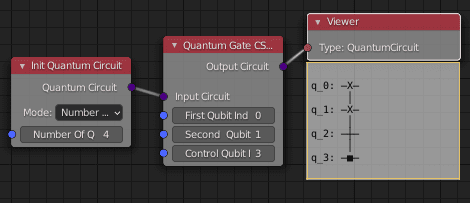Quantum Gates
Note
This section of the documentation is a list of all the nodes that have been implemented in Quantum Nodes.
We recommend you try and practice all these nodes in Blender to really see what they can create as the content of this list can be difficult to visualize.
Single-qubit gates
Note
The following nodes send errors if the indices go beyond the number of qubits in the circuit but the number of qubit indexes is up to the user.
Gate to all circuit
Input: Quantum Circuit
Output: Quantum Circuit
Usage: Applies the H, ID, D, SDG, T, TSG, X, Y or Z gates to all qubits in the circuit.
Description: The Hadamard gate is a single-qubit operation that maps the basis state ∣0⟩ to 2∣0⟩+∣1⟩ and ∣1⟩ to 2∣0⟩−∣1⟩, thus creating an equal superposition of the two basis states.
Expected result: The Hadamard gate can be expressed as a 90º rotation around the Y-axis, followed by a 180º rotation around the X-axis.

Gate H
Input: Quantum Circuit
Output: Quantum Circuit
Usage: Applies the H gate to all qubit indices requested by the user.
Description: The Hadamard gate is a single-qubit operation that maps the basis state ∣0⟩ to 2∣0⟩+∣1⟩ and ∣1⟩ to 2∣0⟩−∣1⟩, thus creating an equal superposition of the two basis states.
Expected result: The Hadamard gate can be expressed as a 90º rotation around the Y-axis, followed by a 180º rotation around the X-axis.
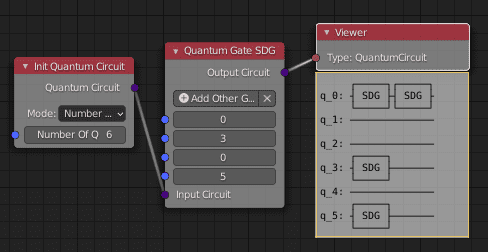
Gate ID
Input: Quantum Circuit
Output: Quantum Circuit
Usage: Applies the ID gate to all qubit indices requested by the user.
Expected result: This gate will not show visible results as it is a "do-nothing" gate.

Gate S
Input: Quantum Circuit
Output: Quantum Circuit
Usage: Applies the S gate to all qubit indices requested by the user.
Description: The S gate (or Phase gate) is a single-qubit operation.
The S gate is equivalent to the RZ gate for the angle pi/2.
Expected result: The S gate represents a 90-degree rotation around the z-axis.

Gate SDG
Input: Quantum Circuit
Output: Quantum Circuit
Usage: Applies the SDG gate to all qubit indices requested by the user.
Description: The S Dagger Gate (SDG gate) is the conjugate transpose (inverse) of the S gate.

Gate T
Input: Quantum Circuit
Output: Quantum Circuit
Usage: Applies the T gate to all qubit indices requested by the user.
Description: The T gate is a single-qubit operation.
The T gate is equivalent to the RZ gate for the angle pi/4.

Gate TDG
Input: Quantum Circuit
Output: Quantum Circuit
Usage: Applies the TDG gate to all qubit indices requested by the user.
Description: The T Dagger Gate (TDG gate) is the conjugate transpose (inverse) of the T gate.

Gate X
Input: Quantum Circuit
Output: Quantum Circuit
Usage: Applies the X gate to all qubit indices requested by the user.
Description: The X or Pauli-X gate is a single-qubit rotation through π radians around the x-axis.

Gate Y
Input: Quantum Circuit
Output: Quantum Circuit
Usage: Applies the Y gate to all qubit indices requested by the user.
Description: The Y or Pauli-Y gate is a single-qubit rotation through π radians around the y-axis.

Gate Z
Input: Quantum Circuit
Output: Quantum Circuit
Usage: Applies the Z gate to all qubit indices requested by the user.
Description: The Z or Pauli-Z gate is a single-qubit rotation through π radians around the z-axis.

Rotation gates
Gate RX
Input: Quantum circuit, index of the target qubit to which we want to apply the gate, angle of rotation
Output: Quantum Circuit
Usage: Applies the RX gate to a chosen qubit depending on the angle provided.
Description: The Rx gate is one of the Rotation operators. The Rx gate is a single-qubit rotation through angle θ (radians) around the x-axis.
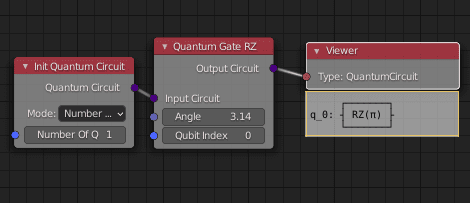
Gate RY
Input: Quantum circuit, index of the target qubit to which we want to apply the gate, angle of rotation
Output: Quantum Circuit
Usage: Applies the RY gate to a chosen qubit depending on the angle provided.
Description: The Ry gate is one of the Rotation operators. The Ry gate is a single-qubit rotation through angle θ (radians) around the y-axis.

Gate RZ
Input: Quantum circuit, index of the target qubit to which we want to apply the gate, angle of rotation
Output: Quantum Circuit
Usage: Applies the RZ gate to a chosen qubit depending on the angle provided.
Description: The Rz gate is one of the Rotation operators. The Ry gate is a single-qubit rotation through angle θ (radians) around the y-axis.

NOT gates
Gates CX, CY, CZ, CH
Input: Quantum circuit, index of the control qubit, index of the target qubit
Output: Quantum Circuit
Usage: Applies the CX, CY, CZ or CH gate to a target qubit depending on a control qubit specified by the user.
Description: The CNOT gate is two-qubit operation, where the first qubit is usually referred to as the control qubit and the second qubit as the target qubit.
The CX, CY, CZ, CH gates leave the control qubit unchanged and performs a X, Y, Z or H gate on the target qubit when the control qubit is in state
∣1⟩ or leave the target qubit unchanged when the control qubit is in state ∣0⟩.Simply, these gates apply a X, Y, Z or H gate on the target qubit if the control qubit is in the
|1⟩ state.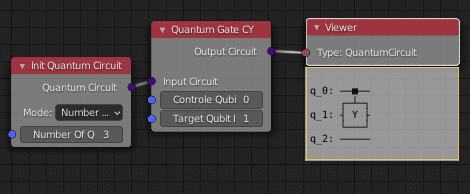
Other gates
Gate CCX
Input: Quantum circuit, index of a first qubit, index of second qubit, index of the target qubit
Output: Quantum Circuit
Usage: Applies the X gate to a target qubit depending on two control qubits specified by the user.

Gate SWAP
Input: Quantum circuit, index of a first qubit, index of second qubit
Output: Quantum Circuit
Usage: Applies the SWAP gate on two qubits.
Description: The SWAP gate is two-qubit operation.
Expressed in basis states, the SWAP gate swaps the state of the two qubits involved in the operation.
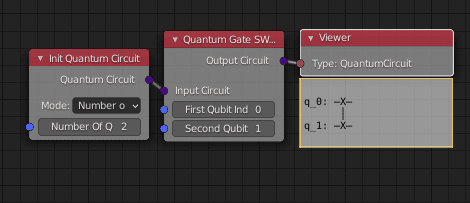
Gate CSWAP
Input: Quantum circuit, index of a first qubit, index of second qubit, index of the control qubit
Output: Quantum Circuit
Usage: Applies the CSWAP gate on two qubits depending on a control qubit given by the user.
Description: The CSWAP gate is two-qubit operation.
Expressed in basis states, the CSWAP gate swaps the state of the two qubits involved in the operation depending on a control qubit.
